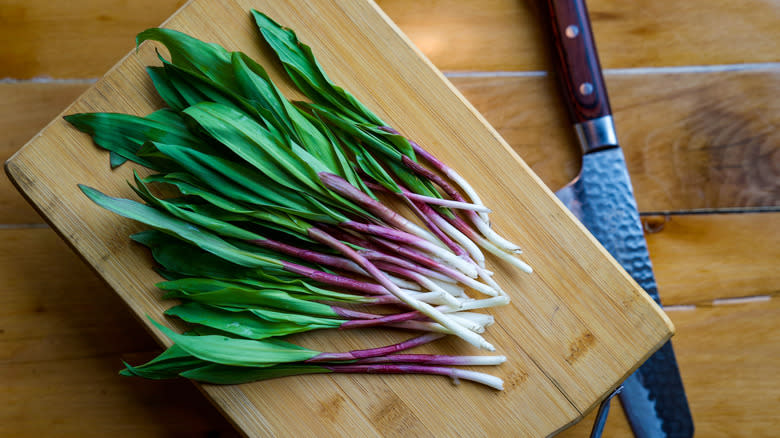The Best Way To Store Ramps For Maximum Freshness

Part of what makes the pungent, spicy, oniony, garlicky goodness of ramps so special is how fleeting the vegetable's appearance is every year. One of the things that defines the ramp is its brief springtime window of growth, which restaurant and home chefs take full advantage of with plenty of ramp-starring dishes. But are ramps themselves as short-lived as their growing season? How long do they last once they're in your kitchen, and how can you store them to maximize their peak freshness?
A foraged vegetable, ramps will often be sold with dirt still clinging to their roots. You can rinse that off when you get them home, but save a full wash for right before you're about to use them, so you don't saturate them before storing, which could lead to premature wilting. Speaking of wilting, it's a good idea to trim away any already wilted leaves, as well as root ends, so you're only storing the healthy parts of the ramp that have the potential to last as long as possible. Wrap your rinsed, dried, and trimmed ramps in a damp paper towel and refrigerate that bundle in your crisper, an airtight container, or a plastic bag that has just a tiny opening. Basically, you want the ramps to be able to breathe, but you also don't want them fully exposed to bacteria and therefore possible spoilage. Properly wrapped and stored, ramps can last up to a week in the fridge.
Read more: What Happens If You Accidentally Eat Mold?
How To Freeze Ramps And Enjoy Them Year-Round

You can get six months out of your ramps by freezing them. Either chop the ramps' leaves, leave them out for a few hours to make sure they're fully dry, and then put them into your freezer in an airtight container, or, better yet, blanch them first. This is effective because blanching involves transferring vegetables from a boil to ice-cold water in seconds, which halts the cooking process and enzyme activity that leads to wilting and degradation. So, you're locking the ramps' flavor and texture in place before freezing them.
To blanch your ramps, boil them for about 30 seconds and then get them right into the ice bath, or you can take the shortcut of running them under super cold tap water. Let them cool and gently dry them. Once they're dry, line them up on a baking sheet and put them in the freezer until they're totally frozen, at which point you can put them into an airtight container or storage bag.
The possibilities with ramps are pretty endless. You can eat them blanched, which is great in a salad, or you can saute them, grill them, or roast them. This should make enjoying your ramps before they start losing their freshness easy. But to really savor them year-round, a great option is pickling ramps. You'd do this with just the stems and bulbs, and you can get creative, like pickling your ramps with habanero peppers.
Read the original article on Tasting Table.


